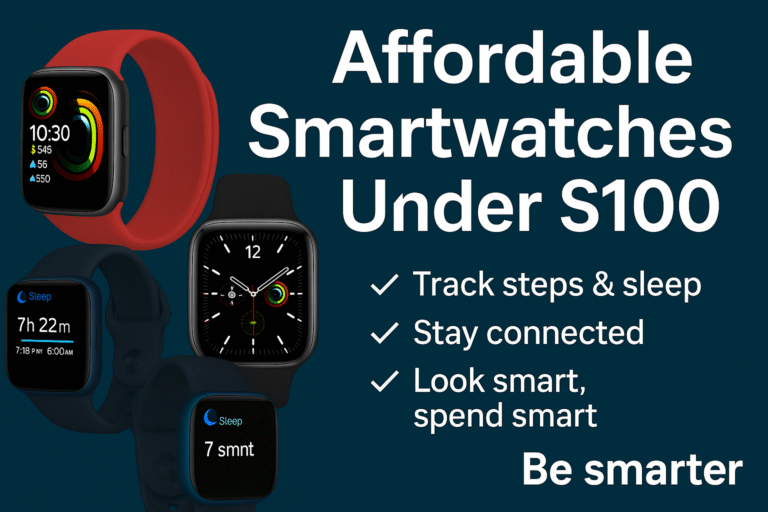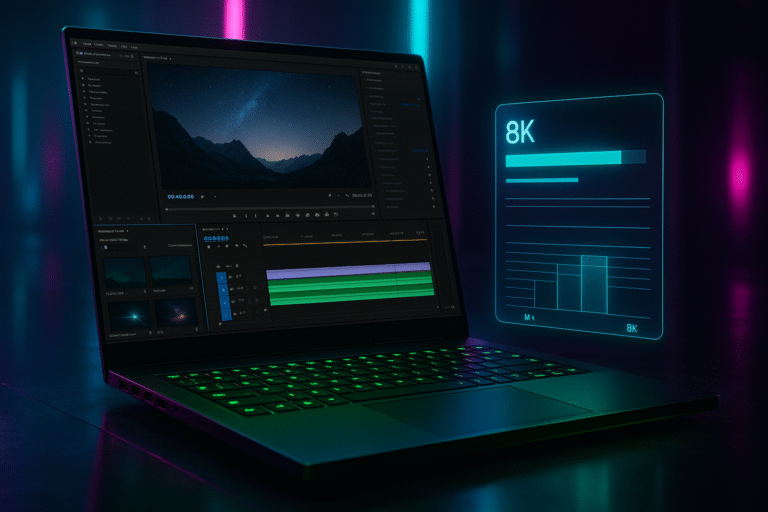Samsung Galaxy Watch 6 Review: Is It Better Than the Apple Watch?
The Samsung Galaxy Watch 6 and the Apple Watch Series 9 are two of the most advanced smartwatches on the market. Both pack the latest health and tech features, but they take different approaches in design, software, and ecosystem integration. In this detailed comparison, we break down how the Galaxy Watch 6 stacks up against the Apple Watch Series 9 across design, display, health tracking, performance, smart features, apps, battery life, and price. Whether you’re a casual user, a tech enthusiast, an Android fan, or an Apple convert, we’ll help you understand which watch may fit your needs best.
Design and Build Quality
The Galaxy Watch 6 and Apple Watch Series 9 have distinct looks. The Galaxy Watch 6 is circular, echoing a traditional watch design, while the Apple Watch is rectangular (sometimes called a “squircle”. This difference affects how you interact with the screen: the Apple Watch’s shape shows more data (no corners cut off) and is sometimes seen as a modern status symbol, whereas the Galaxy’s round face has a classic watch aestheti. Both watches come in two case sizes (Apple: 41mm & 45mm; Galaxy: 40mm & 44mm) to suit different wrists.
In terms of materials and durability, Samsung takes the lead on base model build. The Galaxy Watch 6 uses sapphire crystal on both the front and the underside of its aluminum body, making it very scratch-resistant. By contrast, the entry-level Apple Watch Series 9 uses Ion-X strengthened glass (which can scratch more easily), and only the pricier stainless steel Apple Watch models get sapphire glass. Both watches are built to handle daily life: they are water-resistant (up to 50 meters) and rated for dust resistance. Samsung’s watch even carries a MIL-STD-810H military durability rating, while Apple rates the Series 9 with IP6X (dust) and WR50 (water). In practice, this means both should survive workouts and rain, but the Galaxy Watch 6 may scratch less easily thanks to its sapphire cover.
Another design element is how you change straps. Both Apple and Samsung now use easy “quick-release” band mechanisms. The Apple Watch has had a slide-in strap system for years; the Watch 6 finally gets Samsung’s version of a quick-release pin that makes swapping bands much faster than older spring-bar straps. The classic Galaxy Watch 6 Classic even brings back a physical rotating bezel (for those who like a tactile way to scroll), which the Apple Watch doesn’t have.
Key design highlights:
- Shapes: Galaxy Watch 6 is round vs. Apple Watch rectangular.
- Materials: Samsung base model has sapphire glass (both sides) vs. Apple’s Ion-X front (sapphire only on expensive models).
- Sizes & weight: Both have small/large case options. The 44mm Galaxy Watch weighs under 34g (no strap) vs. 38.7g for the 45mm Apple Watch.
- Bands: Both support quick-swap straps; Samsung introduced a new one-click band latch.
- Durability: Both are water and dust resistant. Samsung’s watch meets military shock standards and has a sapphire screen.
Both watches offer a premium feel, but the Galaxy Watch 6 slightly edges out for raw build toughness due to sapphire glass as standard. Design preference is personal: the Galaxy Watch will feel like a classic timepiece, while the Apple Watch looks more high-tech and fashion-forward.
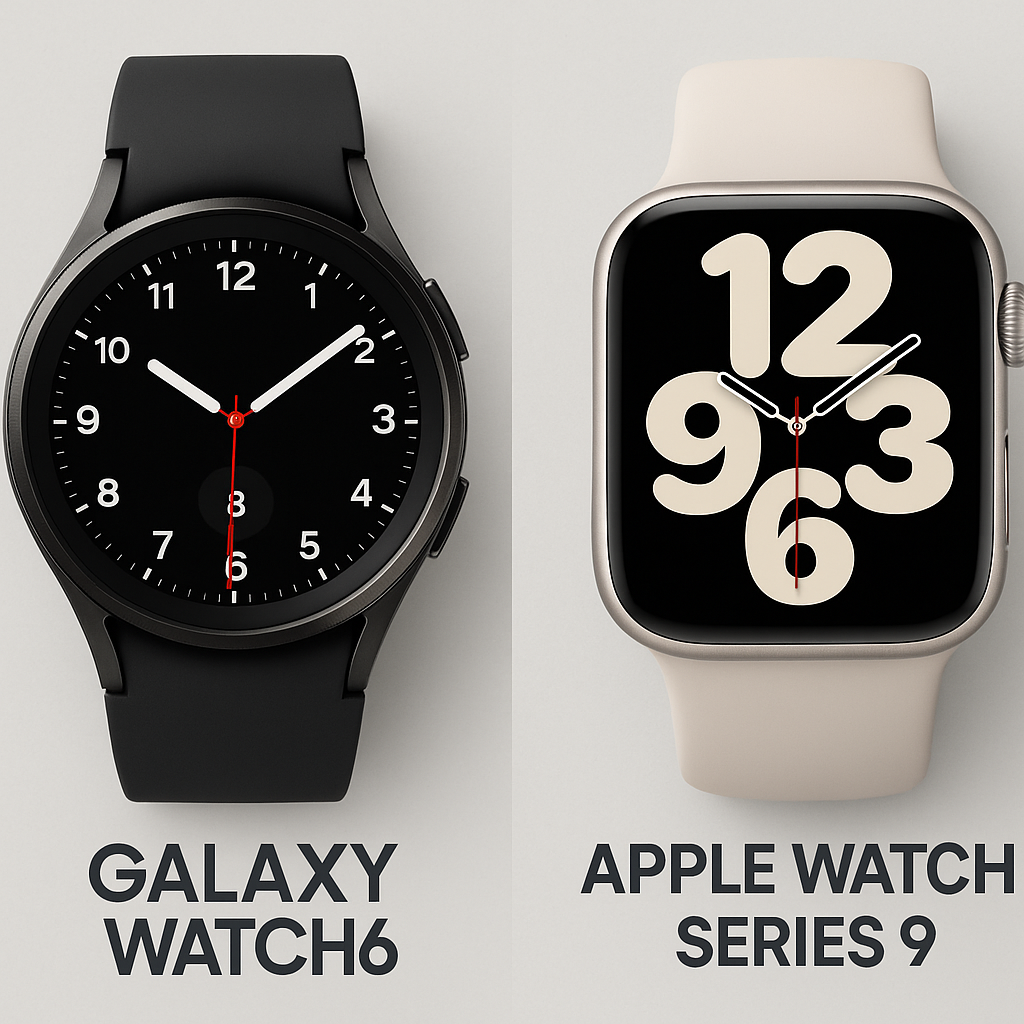
Display and Screen Performance
The Galaxy Watch 6 and Apple Watch Series 9 both have sharp OLED screens, but with different sizes and shapes. The Galaxy Watch 6 (in its two sizes) uses Super AMOLED circular displays: 1.3 inches (432×432 pixels) and 1.5 inches (480×480). In contrast, the Apple Watch Series 9 has retina OLED screens that are larger in one dimension: 1.6 inches (352×430) and 1.8 inches (396×484). Even though Apple’s diagonal is bigger, both watches end up with similar pixel density (around 326 pixels per inch) due to the squircle layout versus a circle.
In practical terms, both displays look extremely crisp and vibrant. They both now boast extremely high brightness levels – up to 2,000 nits at peak. Samsung introduced a 2,000-nit screen on the Watch 5, and Apple caught up on the Series 9. In bright sunlight, either watch is readable, though cranking brightness so high drains the battery faster. The Galaxy Watch 6 screen tends to wrap nearly edge-to-edge (30% smaller bezel than its predecessor), giving it a modern, immersive look. The Apple Watch went edge-to-edge back on Series 7; its display easily shows full app UIs and feels like a small smartphone on the wrist.
Both watches offer Always-On Display (AOD) modes for quick glances, though this affects battery life. Samsung claims about 30 hours battery life with AOD on for the Galaxy Watch 6, while Apple’s Series 9 is rated for up to 18 hours in normal use (Apple doesn’t quote AOD mode, but expect it shorter than Samsung’s).
On the interface side, the Galaxy Watch’s watch faces and apps often use circular layouts and a capacitive touch bezel around the edge for app navigation. The Apple Watch uses a digital crown for precise scrolling and zooming, which some users prefer for exact control. Visually, Apple’s squircle means you never “lose” content around the corners, while the Galaxy Watch sometimes shows watch faces or notifications in a perfect circle with no corner cropping.
Key display points:
- Screen size & resolution: Galaxy Watch 6 – 1.3″/432×432 & 1.5″/480×480; Apple Watch 9 – 1.6″/352×430 & 1.8″/396×484.
- Pixel density: Both about 326 ppi, so text and graphics look very sharp.
- Brightness: Both peak ~2,000 nits – extremely bright for outdoor use.
- Always-On Display: Supported on both; Samsung’s AOD mode with minimal updates claims ~30h battery, Apple ~18h (no AOD spec).
- Screen borders: Galaxy Watch 6 has slim bezel (30% smaller than Watch5); Apple Watch’s bezel was slimmed on Series 7.
- Interaction: Galaxy uses touch + swipe and a digital bezel; Apple uses touch and a physical crown.
Overall, both watches have excellent displays. The Galaxy Watch 6’s screen is very bright and traditional circular, while the Apple Watch’s squircle display shows off more information around the edges. Your preference for round versus square, and Samsung’s bezel vs Apple’s crown, might decide which display you like more.
Health and Fitness Tracking
Both watches are packed with health and fitness sensors, but they differ in some capabilities and accuracy. Here are the main health-tracking features:
- Heart Rate & ECG: Both watches have optical heart rate monitors, and both support ECG (electrocardiogram) measurements for heart rhythm. Apple Watches have long been praised for very accurate heart rate sensing – they’re often as accurate as chest straps during exercise. In tests, the Apple Watch maintained excellent tracking during runs, while the Galaxy Watch tended to have occasional discrepancies. In short, Apple’s heart-rate tracking is considered a “gold standard” in smartwatches, though the Galaxy Watch 6 is still quite good and much improved over older models.
- Heart Rhythm (AFib) Alerts: Both the Galaxy Watch 6 and Apple Watch 9 can detect irregular heart rhythms. The Apple Watch actively monitors for atrial fibrillation and can alert you, and on Galaxy Watch 6 Samsung added passive irregular-rhythm alerts (though these alerts require a Samsung phone to deliver the notifications).
- Blood Oxygen (SpO₂): Both watches measure blood oxygen levels on demand (SpO₂), which can be useful for workouts or health monitoring. They use similar optical sensors, so accuracy should be comparable.
- Skin Temperature: The Apple Watch Series 8 and 9 added a skin temperature sensor mainly for menstrual-cycle tracking (optional), and the Galaxy Watch 6 also includes a skin temperature sensor. Neither watch uses temperature for general body temp readings, but for tracking trends it’s there.
- Body Composition (Body Fat and BMI): This is where the Galaxy Watch 6 has a unique feature. It includes a Bioelectrical Impedance Analysis (BIA) sensor – Samsung calls it its BioActive Sensor – which can estimate body fat percentage and BMI. The Apple Watch has no equivalent. However, tests show the Galaxy’s body-composition readings can be inconsistent (comparing to a dedicated body-fat scale), so use them cautiously.
- Sleep Tracking: Both watches track sleep stages (light, deep, REM) and total sleep time. In practice, Apple’s algorithms tend to be more accurate for sleep stages. One comparison found that the Series 9 was better at estimating deep sleep correctly, whereas the Galaxy Watch 6 sometimes overestimated it. A nice advantage of the Galaxy Watch 6 is that it can auto-detect and log naps, a feature that the Apple Watch doesn’t natively offer. Both provide a “sleep score” and insights. Samsung has added new sleep analytics (like sleep consistency and even “sleep animals” symbols) to gamify and coach better sleep, whereas Apple focuses on in-app charts and Bedtime schedules in iOS.
- Workout Tracking: Both devices support a wide range of workout modes (running, cycling, swimming, etc.). The Galaxy Watch 6 added some new running features, like a Track Run mode that aligns GPS data to athletic tracks and five personalized heart-rate zones during exercise. The Apple Watch Series 9 continued strong fitness features (interval workouts, running power, auto-workout detection), and it has the advantage of Apple Fitness+ (subscription service with guided workouts). Samsung doesn’t have a direct equivalent service, but its Samsung Health app offers lots of basic workout tracking and challenges. Notably, both watches can auto-detect certain workouts (walking, running, rowing, cycling, elliptical, swimming), although historically the Apple Watch has been faster at recognizing more exercise types, and Samsung just reintroduced auto-cycling detection that had been missing on prior models.
- GPS & Other Sensors: Both have built-in GPS (no dual-band yet, so just L1 GPS), altimeter/barometer, compass, and accelerometers/gyros. Neither watch has multi-band GPS for higher accuracy, though Apple’s Maps can sometimes correct small GPS errors post-workout. Both track altitude gain (important for hiking) and steps/activities.
Summary of health tracking:
- Both watches: Heart rate (with ECG), SpO₂, sleep stages, GPS, accelerometer, compass.
- Apple Only: High sleep tracking accuracy and auto exercise detection. Apple Fitness+ integration, menopausal cycle tracking. Siri can even answer health queries.
- Samsung Only: Body composition (fat/BMI) via BIA sensor. Nap tracking. Track Run mode and custom heart-rate zones. Sleep analytics features.
In general, Apple Watch Series 9 often has a slight edge in tracking accuracy (especially heart rate and sleep) due to mature sensors and algorithms, while Galaxy Watch 6 offers additional sensors (like BIA) and slightly longer battery for long-term tracking. Casual users will find both watches cover the basics (steps, workouts, notifications) extremely well. Serious athletes might prefer Apple’s tried-and-true tracking, but fitness enthusiasts may enjoy Samsung’s new training modes and Body Composition readings.
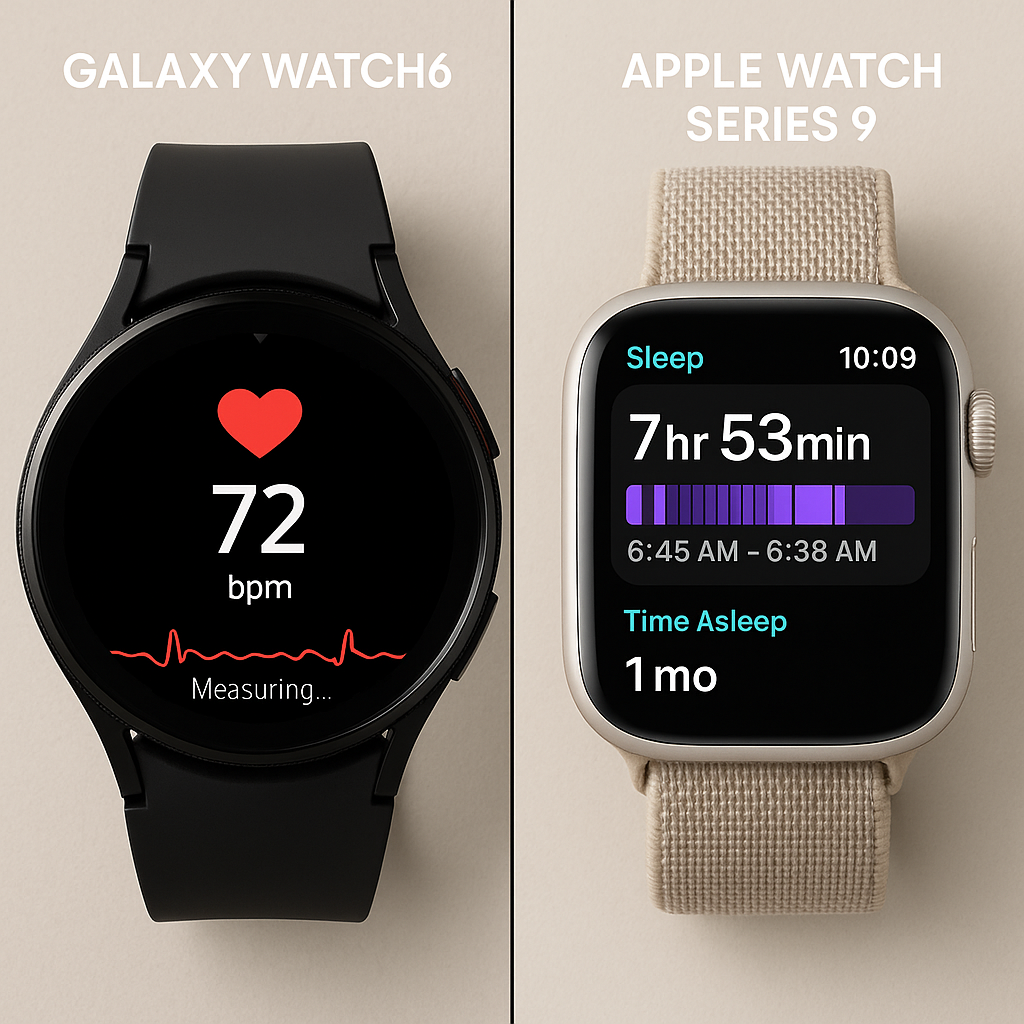
Performance and Software Experience
Under the hood, both watches got hardware upgrades for 2023, and both run mature, polished software (Wear OS 4 on Galaxy, watchOS 10 on Apple).
Hardware and Speed
The Galaxy Watch 6 packs Samsung’s Exynos W930 chipset (1.4 GHz) and 2GB of RAM. This is an upgrade from the Watch 5, giving about 25% faster app switching than before. The Apple Watch Series 9 uses Apple’s new S9 SiP (System in Package) – a 64-bit dual-core processor with a 4-core neural engine. Apple claims it can handle machine-learning tasks twice as fast and has a 30% faster GPU than the S8 chip, thanks to a 60% increase in transistors.
In real life, both feel very snappy and smooth. Our review team noted the Galaxy Watch 6 was “very impressive” in speed, and even though we haven’t benchmarked the Series 9 yet, previous Apple Watches are known for their fluid UI. In short, whether you scroll through menus, open apps, or launch workouts, you’ll rarely notice any lag on either watch. Buying either means you’re getting one of the fastest smartwatch experiences available.
One hardware point to note is storage. Samsung stuck with 16GB on the Galaxy Watch 6 (since Watch 4), whereas Apple doubled from 32GB to 64GB on the Series 9. If you like loading up your watch with a lot of offline music, podcasts, or apps, the Apple Watch has more room. For most users, 16GB on the Galaxy Watch is still adequate (you can stream music from phone or cloud), but heavy media users might prefer Apple’s extra space.
Operating System and Ecosystem
The Galaxy Watch 6 runs Samsung’s One UI Watch 5, which is essentially Wear OS 4 with Samsung’s design flair. The Apple Watch Series 9 runs watchOS 10. Both platforms are polished: watchOS has been around longer and is very refined, while Wear OS has dramatically improved in the last few years, especially since Samsung adopted it.
In practice, your choice may hinge on your phone: Apple Watch only works with iPhones, while the Galaxy Watch 6 only works with Android phones (in fact, Watch 4 and later aren’t compatible with iOS at all). If you have an Android phone (especially Samsung or Pixel), the Galaxy Watch integrates seamlessly with your device. If you have an iPhone, the Apple Watch is essentially your only smartwatch choice for full features.
Feature-wise, both OSes offer similar basics: swipe and tap navigation, customizable watch faces, and widgets/complications. Apple’s watchOS has the App Store on the watch, Siri voice assistant, and deep integration with iOS (calls, messages, Health data sync). Wear OS has the Google Play store, Google Assistant (Galaxy Watch 6) or Samsung’s Bixby (older models) – the Watch 6 uses Google Assistant – and seamless Google account integration. In Series 9, Siri has gotten better with on-device processing and can now answer questions about your health data thanks to the S9 chip. On the Galaxy Watch 6, Assistant works as usual (often faster than Bixby) and can control smart home devices, set reminders, etc.
Samsung promises 4 years of OS updates for the Galaxy Watch 6, while Apple typically supports Apple Watches for about 5 years or more. That means both watches will get major new features for a long time, but Apple watches may get one more generation of updates in the long run.
Key performance/software points:
- Processors: Both new (Galaxy W930 vs Apple S9) – both are fast; virtually no lag.
- Memory/Storage: Galaxy: 2GB RAM + 16GB storage; Apple: unknown RAM + 64GB storage.
- Operating System: Galaxy = One UI Watch (Wear OS 4); Apple = watchOS 10. Both smooth; integration depends on Android vs iPhone.
- Software Support: Samsung 4 years, Apple 5+ years.
- Voice Assistant: Google Assistant on Galaxy Watch 6; Siri on Apple Watch Series 9 (now runs on-device for speed and health queries).
- Integration: Galaxy works best with Android/Samsung phones; Apple Watch only with iPhone.
Overall, the software experience on both watches is strong. The Apple Watch still feels a bit more cohesive if you’re in the iOS world, but Samsung’s Wear OS interface has caught up quickly. Both watches feel fast and responsive; the differences are more about which ecosystem you prefer (Google/Android vs Apple) and the assistant you like using.
Smart Features
Both watches offer the core “smartwatch” features: notifications, calls, payments, music, and voice assistants, but again with an Apple vs Samsung flavor.
- Calls & Messages: Both watches can display smartphone notifications and allow replies. On Apple Watch (paired with an iPhone), you can take phone calls, send iMessages, and even do FaceTime audio using the watch’s speaker/mic (if the watch has cellular or is connected via Bluetooth). The Galaxy Watch 6 (paired to an Android phone or LTE version) can also answer calls and send texts using its own mic/speaker or via Bluetooth headset. In practice, the Apple Watch’s integration with iPhone is typically smoother (messages automatically sync, rich replies, etc.), whereas the Galaxy Watch 6 relies on Android’s notification mirror and messaging apps (but Samsung has its own messaging apps if you use a Samsung phone).
- Voice Assistants: The Galaxy Watch 6 comes with Google Assistant (Samsung moved to Google’s assistant on Wear OS). The Apple Watch uses Siri, which on the Series 9 now works on-device. Both can do similar tasks: set timers, send quick texts, answer questions, control smart home devices, etc. Many reviewers find Google Assistant to be quicker and more flexible, while Siri is improving (especially for health-related queries thanks to on-device processing)androidcentral.com. The main point: whichever phone ecosystem you’re in, you’ll have the corresponding assistant on your watch.
- Mobile Payments: Both watches support contactless payments via NFC. The Galaxy Watch 6 can use Google Wallet (Google Pay) for most banks, and on Samsung phones it can also use Samsung Wallet/Pay. Apple Watch uses Apple Pay for NFC payments. Each watch only works with its own wallet system – you can’t use Apple Pay on Android and vice versa. In either case, you get the convenience of paying with your wrist.
- Notifications: Both can mirror notifications from your phone, so you get texts, email alerts, social app notifications, calendar reminders, etc., right on your wrist. You can usually customize which apps send alerts. Apple’s ecosystem allows direct replies to many notifications (like iMessage, Mail) with quick answers or dictation. The Galaxy Watch 6 (on Android) will let you reply via voice or canned messages for most apps too. Both have feature parity here, and differences are mostly about what apps you use on the phone.
- Find My Phone/Find My Watch: Apple Watch has ultra-wideband (UWB) on the Series 9, so if you misplace your watch, you can use Precision Finding with an iPhone (and vice versa). The Galaxy Watch 6 does not have UWB; if you lose it you’re limited to basic Bluetooth find-my-device functions or Samsung’s Find My Mobile service.
Smart feature summary:
- Voice: Google Assistant (Galaxy) vs Siri (Apple).
- Payments: Google/Samsung Wallet (Galaxy) vs Apple Pay (Apple).
- Calls/Messaging: Both support them when paired; Apple’s integration on iPhone is more seamless.
- Notifications: Very similar on both; both mirror phone alerts.
- Unique: Apple Watch has UWB for Precision Find; Galaxy Watch works on Android only.
The bottom line is that on smart features, both watches are feature-rich and largely comparable, each offering the essentials plus a few unique perks (UWB on Apple, Google Assistant on Samsung). Your choice here will mostly depend on your phone and personal preference of assistant/payments: if you use an iPhone and Apple’s services, the Apple Watch will fit right in. If you’re on Android and use Google’s services, the Galaxy Watch 6 is fully integrated.
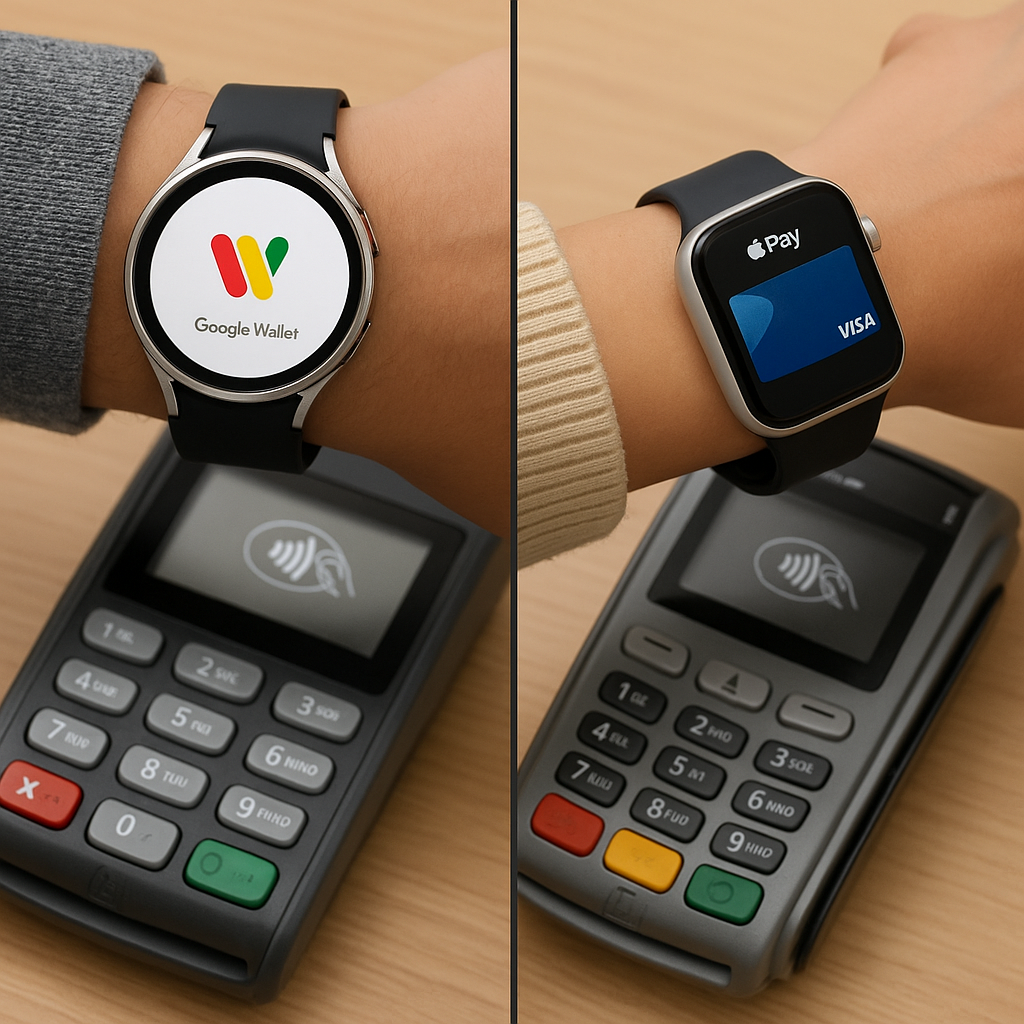
App Ecosystem
A key difference between Samsung’s Wear OS watch and the Apple Watch is the app ecosystem. The Apple Watch has a very large and mature App Store with thousands of dedicated apps (fitness, productivity, travel, music, etc.). Many app developers in health and fitness still often prioritize iOS/watchOS, so apps like Strava, MyFitnessPal, or banking apps tend to have great Apple Watch versions.
Wear OS (including the Galaxy Watch 6) has historically had fewer watch-specific apps, but it has been catching up. The Google Play Store on the watch lets you install many apps – major ones like Spotify, Google Maps, Strava, Calm, and WhatsApp are available on Wear OS. Android Central notes that “even though some developers tend to prioritize Apple Watch apps, you’ll still find high-quality apps on Wear OS… especially as it has become more popular and better supported in recent years”. Samsung itself has a Galaxy Store with watch faces and some apps, but many users simply use the Google Play Store on the Watch 6.
That said, Apple still leads in sheer volume and polish of apps. If there’s a very popular app on your phone, chances are the Apple Watch has a slick counterpart. Some specialized apps (for example, certain medical or workout apps) might be iOS-only. On Wear OS, you get the advantage of Google integration (e.g. Google Keep, Google Wallet, etc.), which Apple lacks. In general:
- Apple Watch Series 9: Extensive app library. Siri Shortcuts, HomeKit (for smart home apps), Apple Fitness+, Apple Music, etc. Many developers launch on Apple Watch first.
- Galaxy Watch 6 (Wear OS): Growing app library. Google apps (Maps, Pay/Wallet, Assistant, etc.) and Android-friendly apps. Samsung Health and Samsung Wallet (on Samsung phones) also add some ecosystem features.
Most everyday apps you need (email, chat, navigation, fitness tracking) exist on both. If a particular app is crucial to you, check if it’s supported on your chosen platform. But for general use, both offer strong app support.
Battery Life and Charging
Smartwatch battery life is often a hot topic. In this round, the Galaxy Watch 6 has the advantage of larger batteries and modest power draw. Samsung quotes about 40 hours of typical use for the 44mm model (and about 40 hours for the 40mm model, while Apple quotes up to 18 hours for the Series 9 in typical use. In real-world tests, both watches usually last about a day or slightly more, not multiple days. PhoneArena found that in normal conditions, you can expect roughly 30 hours of use on either watch, meaning you’ll need to charge overnight if worn all day.
However, the bigger Galaxy Watch (44mm) has a larger 425 mAh battery, compared to Apple’s 45mm at 308 mAh. In practice, that tends to give Samsung a bit more endurance. Samsung also points to around 30 hours with Always-On Display active, whereas the Series 9 is rated for about 18 hours (and likely less if AOD is always on). Many users report getting just over 1 day on Apple and up to 1.5 days on Galaxy Watch 6, depending on usage. If you’re a very light user (no workouts, mostly notifications off), you might stretch either watch into a second day, but that’s the upper limit.
When it comes to charging, both use wireless charging pads. The Galaxy Watch 6 supports “fast charging” – you can go from 0% to 50% charge in about 30 minutes, 75% in 45 minutes, and a full charge in about 75 minutes. The Apple Watch Series 9 also supports fast charging; it reaches about 80% in 45 minutes and 100% in 75 minutes (Apple changed its charging profile slightly, emphasizing the 80% benchmark). In summary, charging speeds are comparable and fast enough to do an overnight or a quick top-up.
Key battery points:
- Capacity: Galaxy Watch 6 – 300 mAh (40mm) or 425 mAh (44mm); Apple Watch S9 – 282 mAh (41mm) or 308 mAh (45mm).
- Daily life: Expect roughly 1 day (24–30h) of active use on either. Galaxy’s larger model can edge out into a second day with light use.
- Always-On: Significantly reduces battery (Samsung’s 30h spec is with AOD; Apple’s 18h is likely without AOD).
- Charging: Both ~75 minutes to full. 30 minutes of charging gives ~40% (Galaxy) or ~50% (Apple).
Overall, Galaxy Watch 6 has a slight battery-life edge, especially in its larger size, but both watches need daily charging for intensive users. If battery is a top concern, Galaxy Watch (especially the 44mm) may be preferable; but you should still plan to charge it every night.
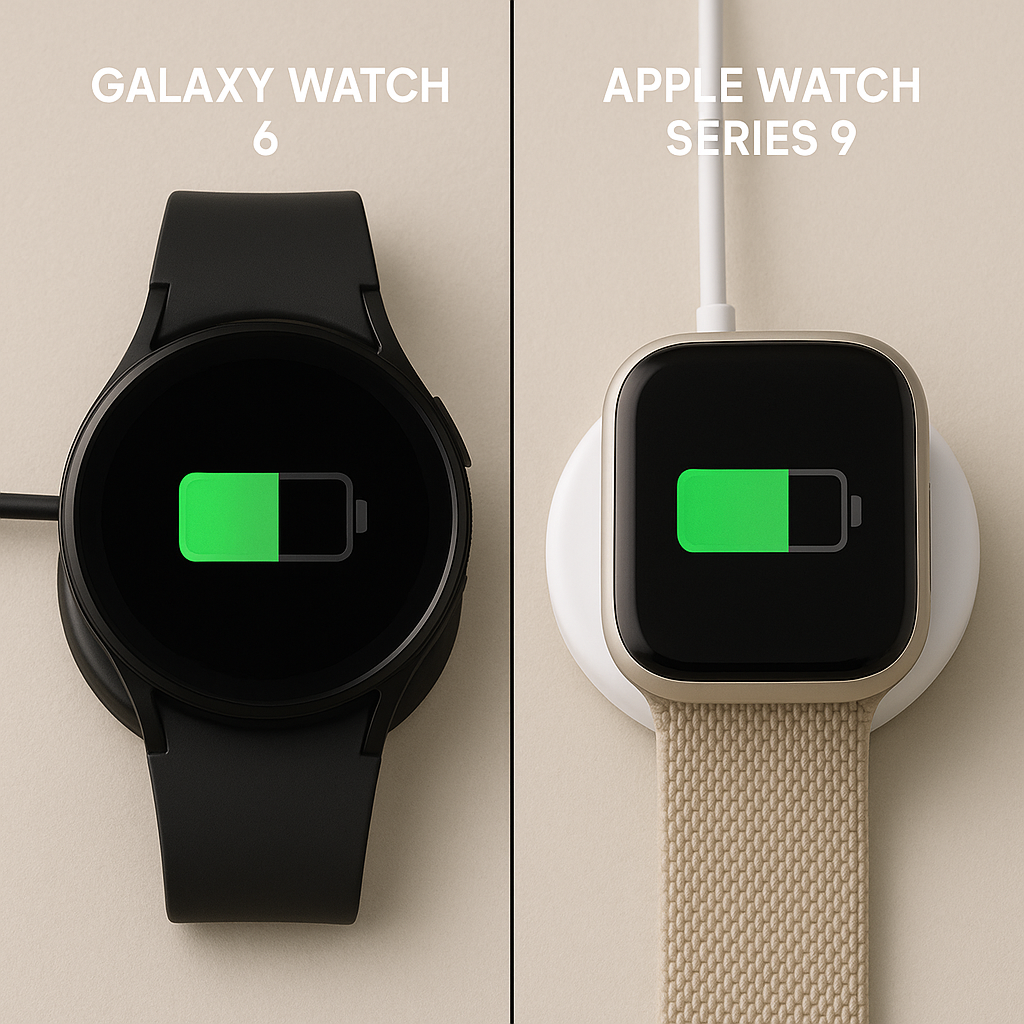
Price and Value for Money
When it comes to pricing, the Galaxy Watch 6 is generally more affordable. The base Galaxy Watch 6 (aluminum) starts at around $299 for the smaller size, whereas the Apple Watch Series 9 starts at $399 for its aluminum model. Apple also offers a stainless-steel Series 9 (with sapphire glass) starting around $699, but Samsung’s base model already uses sapphire, so you’re not forced to pay extra for that durability. Even the larger sizes: the 44mm Galaxy Watch 6 may hit around $329, still under the 45mm Apple Watch price.
For what you get:
- Galaxy Watch 6 (≈$300) gives you a premium smartwatch with sapphire glass, all-day health tracking, rotating bezel (Classic), and the Wear OS app ecosystem. It’s especially good value for Android/Samsung users who get full compatibility.
- Apple Watch Series 9 (≈$400) gives you the polished Apple experience, tight iPhone integration, top-tier health sensors, and a richer app ecosystem (including features like Precision Find, double-tap gestures, etc.). For iPhone users, it’s effectively the standard choice.
If budget is a major factor and you’re on Android, the Galaxy Watch 6 represents strong value. You sacrifice a bit in total app market share and iOS-only perks, but gain in price. For Apple users, the higher price of the Series 9 can be justified by its seamless fit into the Apple ecosystem and possibly better resale value down the line.
Pricing comparison (U.S. SRP for base models):
- Galaxy Watch 6: ~$299 (40mm) / ~$329 (44mm).
- Apple Watch Series 9: ~$399 (41mm) / ~$429 (45mm).
- Note: Prices vary with cellular versions and higher-end materials.
Ultimately, both watches are premium devices, but the Galaxy Watch 6 tends to cost less, which boosts its value proposition for many buyers.

Conclusion and Buying Recommendation
Which watch is better? There’s no single answer — it depends on what you need and which smartphone you use:
- For iPhone Users: If you’re already in Apple’s ecosystem, the Apple Watch Series 9 is almost certainly the better choice. It won’t pair with Android, and it offers deeper integration (messages, Health app sync, Siri features) that you can’t get elsewhere.
- For Android Users: The Galaxy Watch 6 is the natural choice. It won’t pair with iOS (after Watch 4, Samsung dropped iPhone compatibility), but on Android it works flawlessly. It provides a top-notch smartwatch experience with fewer limitations and better value than any Apple Watch would on Android.
- Health Tracking Focus: Both are excellent, but if precise heart-rate and sleep accuracy are your priority, the Apple Watch has a slight edge. If you want extra tracking features (body fat, nap logging, personalized run modes) or longer battery life, Samsung has the advantage.
- Design Preference: Some prefer the look of a round watch (Galaxy) vs a square one (Apple). Both offer many watch faces and bands, so choose the style you like wearing daily.
- Budget-Conscious: The Galaxy Watch 6 is cheaper for a similar level of tech, making it great if cost matters and you’re on Android.
- Future-proofing: Apple usually provides one more generation of updates and has a massive app store. If longevity of software updates is crucial, Apple’s history is slightly longer.
In summary, Android/Price lovers may prefer the Galaxy Watch 6, while Apple/iOS users should stick with the Apple Watch Series 9. Both watches are powerful, well-made, and packed with features. Evaluate which platform you’re invested in and which features you personally prioritize (battery life, design, health metrics, etc.) to make the best choice for your needs.
Recommendation: If you use a Samsung or Android phone, go for the Galaxy Watch 6 for great value, excellent build, and battery life. If you live in the Apple ecosystem and want the smoothest integration (especially if you use Fitness+, iPhone apps, and iMessage a lot), the Apple Watch Series 9 is the way to go.
other articles Apple Watch Series 9 vs Samsung Galaxy Watch 6: differences explained
if you need further explanation contact us
read more posts by blog page

